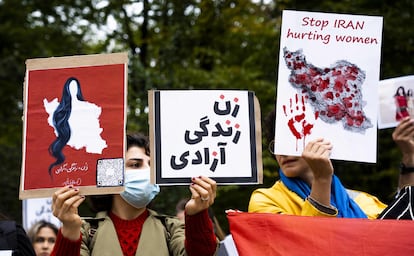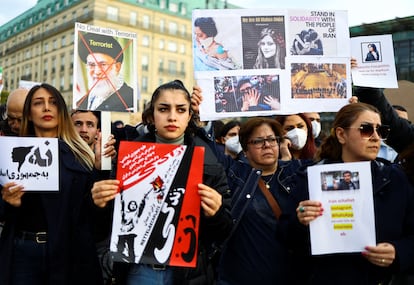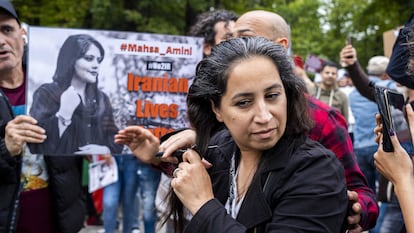Iranian women defy the ayatollahs: ‘The system feels threatened; many young women are angry’
Both in Iran and in exile in Western countries, they are demanding their freedom from Tehran’s Islamic regime

As she made her way home in Tehran on Wednesday, an older man told Kosar, a 24-year-old fine arts student, to “put on your veil or we will kill you.” She was returning from one of the many demonstrations that have erupted around the country, sparked by the death of 22-year-old Mahsa Amini on September 16. The young woman died in police custody after she was arrested for not wearing her veil properly and showing some of her hair. Kosar had removed her own headscarf during the protests and did not want to put it back on. “The system feels threatened,” Kosar believes; the mass demonstrations are “the result of the unbearable oppression that affects all of us, men and women, although we women are leading the movement. I’ve never seen the streets like this before, but we need the world not to abandon us,” she says via Telegram.
After a week of protests in Iran, on Friday the Islamist government tried to show its might in the streets. To do so, it called for rallies in favor of the ayatollahs – an honorific title for high-ranking Twelver Shia clergy – and Islamic law. “They always use this approach: they have enough money to fake a demonstration in support of their fundamentalist ideas,” Behnam, a 38-year-old artist and activist, explains via Telegram. “They organize a display like this at least once a year; it always includes anti-United States slogans. This time, the government wanted the rallies to take place in major cities following Friday prayer. Everyone knows they are a farce,” he says from Isfahan.
The counter-protesters that the regime called in linked the protests over Mahsa Amini’s death to the US and its allies. “Death to America. Death to Israel,” chanted defenders of the status quo from Tehran University. They then praised Iran’s supreme leader Ali Khamenei, who has been in power since 1989, and his predecessor, Ruhollah Khomeini. “[The protesters] are attacking our women’s veils,” cleric Esmail Pahlevan told the Efe news agency. “God has ordered women to wear the hijab,” he said. Friday’s rallies were peaceful, a stark contrast to the repression that occurred at the protests over Amini’s death. Thousands of citizens in several dozen cities mobilized, and dozens of people have died. According to the NGO Iran Human Rights, there have been 31 deaths, while state media says that there were 17.
“There are still protests, but many soldiers [are] in the streets as well,” says Behnam. “The Iranian system can be very repressive; the state is strong and people are afraid. I am,” he says. A few years ago, the activist was arrested for attending a feminist demonstration. The beating he endured as a result left visible scars on his body.

Vida Movahed was a pioneer in defying the regime. On December 27, 2017, on Tehran’s Engelab Street, she took off her veil, tied it to a stick and began to wave it silently. She was alone and her gesture – so simple and yet so risky – made her an icon in the fight against mandatory hijabs. Her act lasted only a few minutes before a man pushed her and knocked her to the ground. She was sentenced to a year in jail. “The world thinks these protests are about the hijab, but they aren’t. Women in Iran have much bigger problems than the veil,” explains Yasaman Khleghian, a 33-year-old journalist and activist who has lived in exile in Canada since 2020. “The government doesn’t allow us to have an abortion, we can’t leave the country without our husbands’ or fathers’ permission, we don’t have the right to enter stadiums and if a man kills his daughter, he will only be sentenced to a few years because the law doesn’t protect women,” says Khleghian, who worked for Shargh, Iran’s leading reformist newspaper, for many years. She left the country fearing for her life because she had criticized the government.
Three years ago, powerful protests in Iran left hundreds dead; the authorities never took responsibility. At the time, the population was rising up because of increasing gasoline prices (in a country that has one of the world’s main oil reserves) and the devaluation of Iran’s currency, the rial. But the current protests are different. Never before have so many women – many of them young – waved their veils in public. The protests differ markedly from the pro-ayatollah rallies, which were mostly attended by men. Nor had women ever dared to burn their veils in public and in front of government buildings before. “There are so many of us young women protesting; we are angry and furious,” says 24-year-old Marion, who is from Tehran. She describes the women who go to the demonstrations with their friends, brothers, fathers and boyfriends who also support Iranian women’s complaints. “The presence of women isn’t what differentiates these protests from previous ones; we have always fought alongside men,” Khleghian notes. “The difference is that these are widespread protests, born out of the pain of Mahsa’s murder and focused on the veil, that have involved all sectors of society,” she explains.
Iranian women are under far more pressure than men. While men are also denied their rights, girls who were born 10 or 20 years after the Islamic Revolution have never been able to leave the house without a headscarf or wear miniskirts or short sleeves. Their mothers could do those things, and they never imagined that the revolution would lead to such a rollback of rights over the past four decades. All of that collective suffering has been distilled into this uprising. “The revolt doesn’t have a leader. There aren’t any politicians here. We are the people, and we need the world not to forget about what is happening,” says Niloofar, 25, via Telegram from her home in Tehran. “The internet will be cut off at any moment,” she warns. She fully understands how Mahsa Amini must have felt after her arrest: a few months ago, the morality police arrested Niloofar for not strictly following Islamic dress code.
“I will never forget the fear and stress I endured when I was taken into custody. It’s a feeling that doesn’t go away,” Niloofar recounts. She also decries the country’s “indescribable” political corruption, which has led to poverty for hundreds of thousands of people. “There are so many of us university-educated women who don’t have jobs. Nor do our male colleagues. And that’s unacceptable in a country as wealthy as Iran.” Behman also believes that this rebellion is different: “The culture of citizenship has changed. Before, families used to enforce conservative Islamic norms at home, imposing them on their children, but not now: we are united in the fight against the Islamist dictatorship. But the repression has also become harsher and crueler: first, we lost our youth and now our blood and our bodies.”
Iranian women’s complaints began in 1979
Iranian women have never taken a backseat when it comes to expressing popular discontent. In 1979, they protested en masse when the new Islamic government announced that wearing the veil was mandatory. At the time, they shouted that they hadn’t participated in a revolution to go backward. The forced veil policy was followed by the repeal of many more rights, which women had won under Shah Mohammad Reza Pahlavi, who sought to modernize a country characterized by deep social inequalities. Over time, a more relaxed way of wearing the hijab has become common, and campaigns from abroad – like the White Wednesdays movement spearheaded by US-based Iranian journalist Masih Alinejad – have encouraged Iranian women to publicly protest the compulsory veils.
“We need for the world not to abandon us. We have always been alone. When it comes to Iran, the West looks the other way. Please don't abandon us,” pleads 24-year-old student Kosar. That’s a sentiment that many expatriates and exiles abroad share. Mina Joshghani is one of them. She resides in the UK now but worked as a journalist in Iran until 2019. She went to London to study and is now a well-known voice on the BBC's Persian language channel. Her job with the British media means that her safety can’t be guaranteed in Iran; when she wants to see her family, she must go to Istanbul to do so. “These days, people are shouting in the streets, ‘From Kurdistan to Tehran, how far do you want to suppress women in Iran?’ This time, it seems that women have decided that they won’t stop, a sign of how fed up they are with being denied their freedom. People are no longer scared; they just can't take it anymore,” adds Joshghani.
Yasaman Khleghian, 33, agrees that something has changed: “I have participated in street protests since I was 18, and I can assure you that the protests over the last few days are unique. I hadn’t seen such unity until now. This could be the first step towards eliminating the hijab law,” says the journalist, who wishes she could participate in the demonstrations. But despite the momentum of the protests, many women fear that nothing will change. They also hope that this time the world will not abandon Iranian women.
Tu suscripción se está usando en otro dispositivo
¿Quieres añadir otro usuario a tu suscripción?
Si continúas leyendo en este dispositivo, no se podrá leer en el otro.
FlechaTu suscripción se está usando en otro dispositivo y solo puedes acceder a EL PAÍS desde un dispositivo a la vez.
Si quieres compartir tu cuenta, cambia tu suscripción a la modalidad Premium, así podrás añadir otro usuario. Cada uno accederá con su propia cuenta de email, lo que os permitirá personalizar vuestra experiencia en EL PAÍS.
¿Tienes una suscripción de empresa? Accede aquí para contratar más cuentas.
En el caso de no saber quién está usando tu cuenta, te recomendamos cambiar tu contraseña aquí.
Si decides continuar compartiendo tu cuenta, este mensaje se mostrará en tu dispositivo y en el de la otra persona que está usando tu cuenta de forma indefinida, afectando a tu experiencia de lectura. Puedes consultar aquí los términos y condiciones de la suscripción digital.
More information
Últimas noticias
Most viewed
- David King, chemist: ‘There are scientists studying how to cool the planet; nobody should stop these experiments from happening’
- Reinhard Genzel, Nobel laureate in physics: ‘One-minute videos will never give you the truth’
- Oona Chaplin: ‘I told James Cameron that I was living in a treehouse and starting a permaculture project with a friend’
- Mexico completes its trade shift with the entry into force of tariffs on China and countries without trade agreements
- Sinaloa Cartel war is taking its toll on Los Chapitos










































